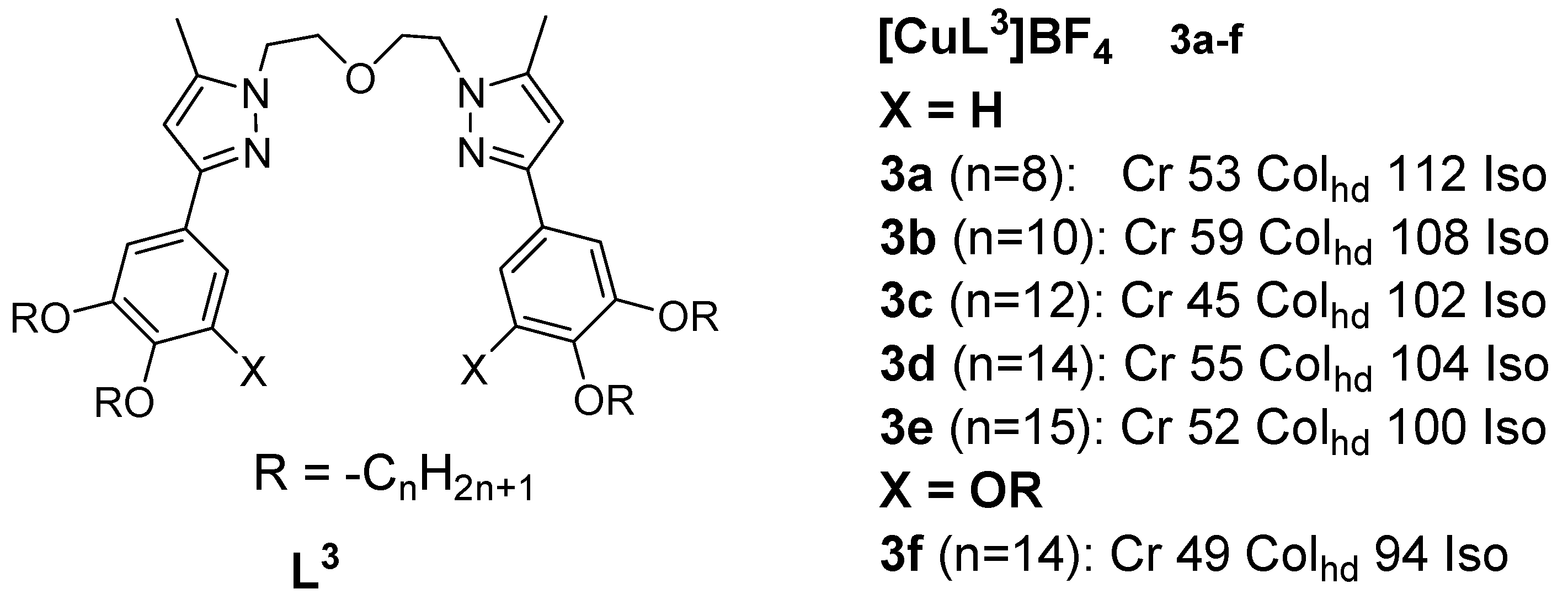LiquThid crystals are generally referred to as substancs paper provides insight into the various studies that blend the structure and properties of solid and have already been carried out on liquid states; they share with liquids the ability to flow but also exhibit some structural arrangement similariticrystalline materials based on copper(I) complexes. Even though the study of copper(I) complexes with solids. With so many compounds synthesized,respect to their liquid crystals containing metals, also known as line property is quite few, metallomesogens, have become a major subject of study. The incorporation of metal into organic matrices enhances and induces unique magnetic, spectroscopic, and redox properties of the resulting materials. At least one liquid crystalline complex has prepared with different structural components and ligands from groups such as aza macrocycles, alkyl thiolates, ethers, isocyanides, phenanthroline, Schiff bases, pyrazoles, phosphine, biquinoline, and benzoyl thiourea have been reported in the literature for most metals. A special section is dedicated to the discussion of the emission properties of copper(I) metallomesogens.
- copper(I)
- metallomesogens
- luminescence
- complex
- ligand
1. Introduction
- Introduction
Copper(I)Liquid complexes have not been studirystals are generally referred to a great extent as luminescent materials in the s substances that blend the structure and properties of solid and liquid crystalline state, but they do possess luminescence properties with great potentialsstates, they share with liquids, the ability to flow but also [1][2][3][4][5][6][7][8][9][10]. Copper, wxhich is somewhat abundant and affordable, is a suitable alternative to noble metal complexes [11][12]bit some structural arrangement similarities with the solids. Theis ratio of triplet to singlet excitons is 3:1; consequently, for luminescent materials to be used in OLEDs, they should essentially be able to harvest all the excitons. Because copper(I) complexes exhibit various metal-to-ligand charge-transfer (MLCT) behaviors, they can induce spin orbital coupling of the triplet and singlet states, leading to small energy separations between the energy levels [13]. Thintriguing combination of both the properties of the liquid and solid states gives liquid crystals the ability to induce certain properties that have gained useful applications in the displays of devices such as wristwatches, calculators, portable computers, and flat-screen televisions allows for reverse intersystem crossing (RISC), i.e., singlet harvesting, results well as in sensors, smart windows, optical switches, etc.[1].
Wingth in thermally activated delayed fluorescence (TADF) [14]. Tso many compounds synthersizefored, liquid crystals based on copper(I) complexescontaining metals, also known as metallomesogens, have considerable promise for producing effective luminescent materials for a wide range of optical or electro-optical applications due to the large diversity of possible structures, including mononuclear or polynuclearbecome a major subject of study [2]. Incorporation of the metal into the organic matrix enhances and induces unique magnetic, spectroscopic, and redox properties of the resulting materials [3–9]. At least one liquid-crystalline complexes, and the great potential of emission behavior. In addition, the range of coordination geometries (such as has been reported in the literature for most of the metals. However, issues often encountered with these complexes are those relating to the high transition temperatures usually >100 linearC, plan-trigonal, or tetrahedral) combind the low thermal stability associated with the ligands’ structural design provide a significant benefit for controlling the LCmetallomesogens at elevated temperatures, which are major drawbacks that hinder the study of the physical properties, including their enhanced thermal stability and mesophase type related to both calamitic and discotic materials.
2. Copper(I) Metallomesogens with Sulfur-Containing Ligands

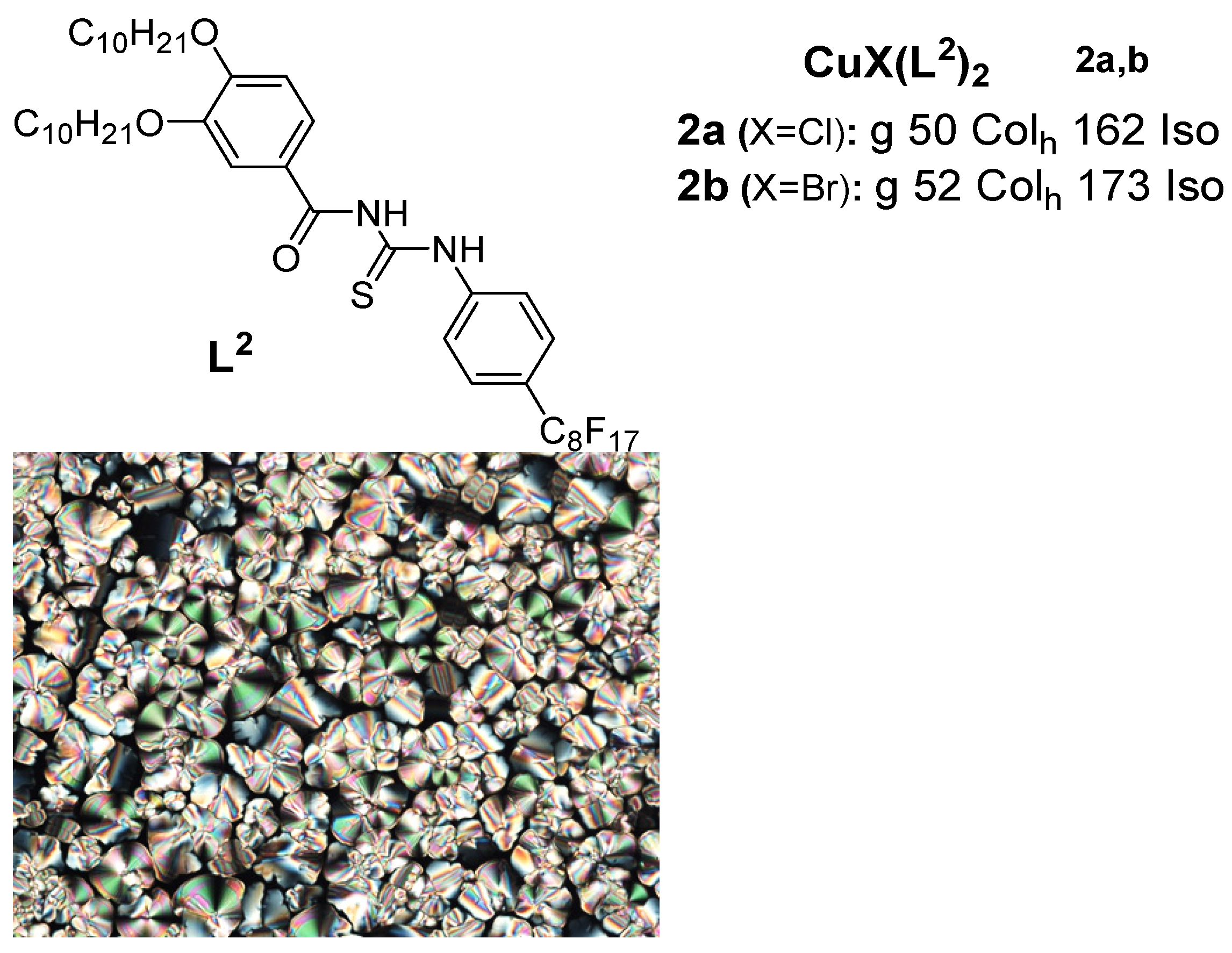
3. Copper(I) Metallomesogens with N-Donor Ligands
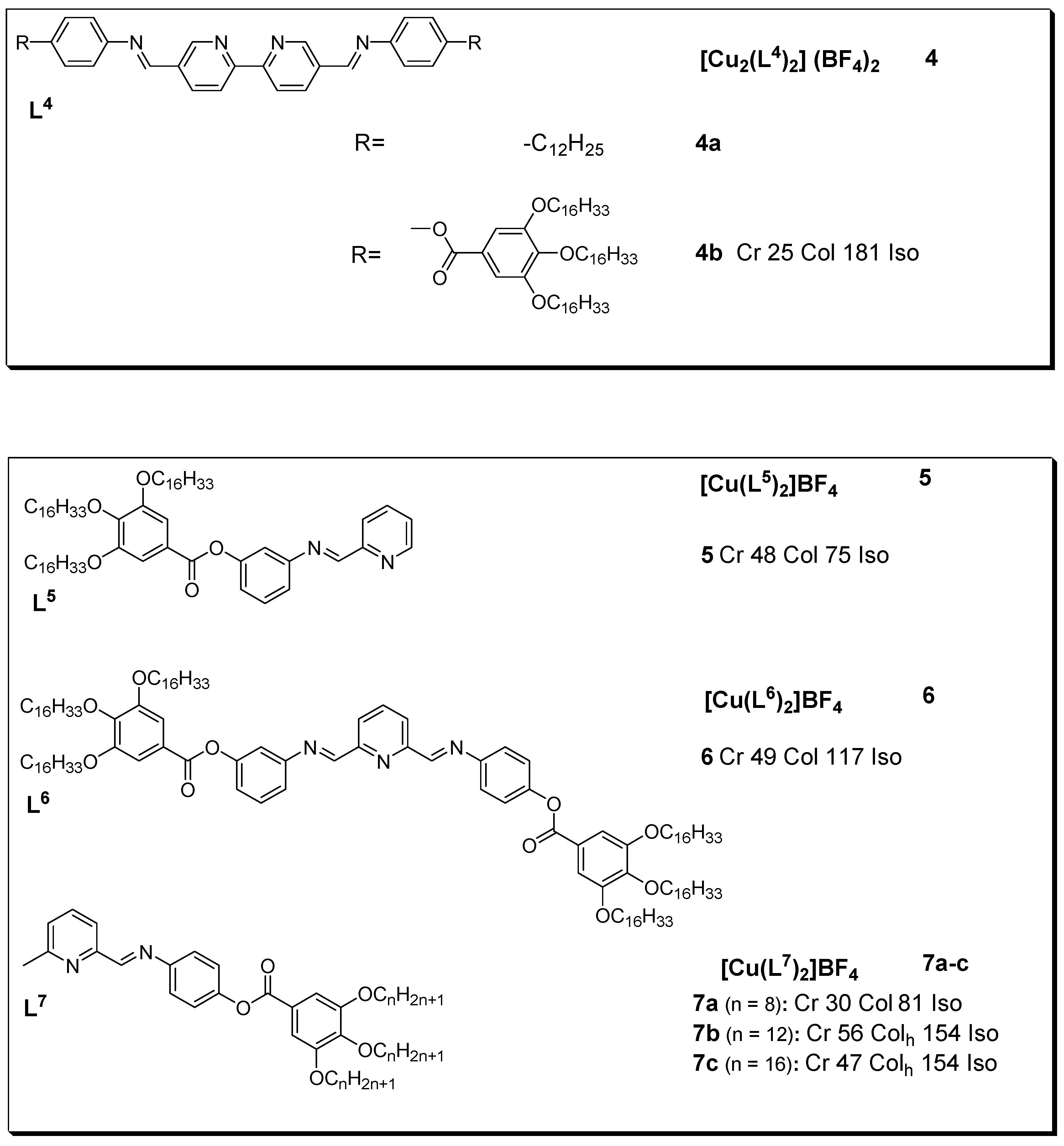
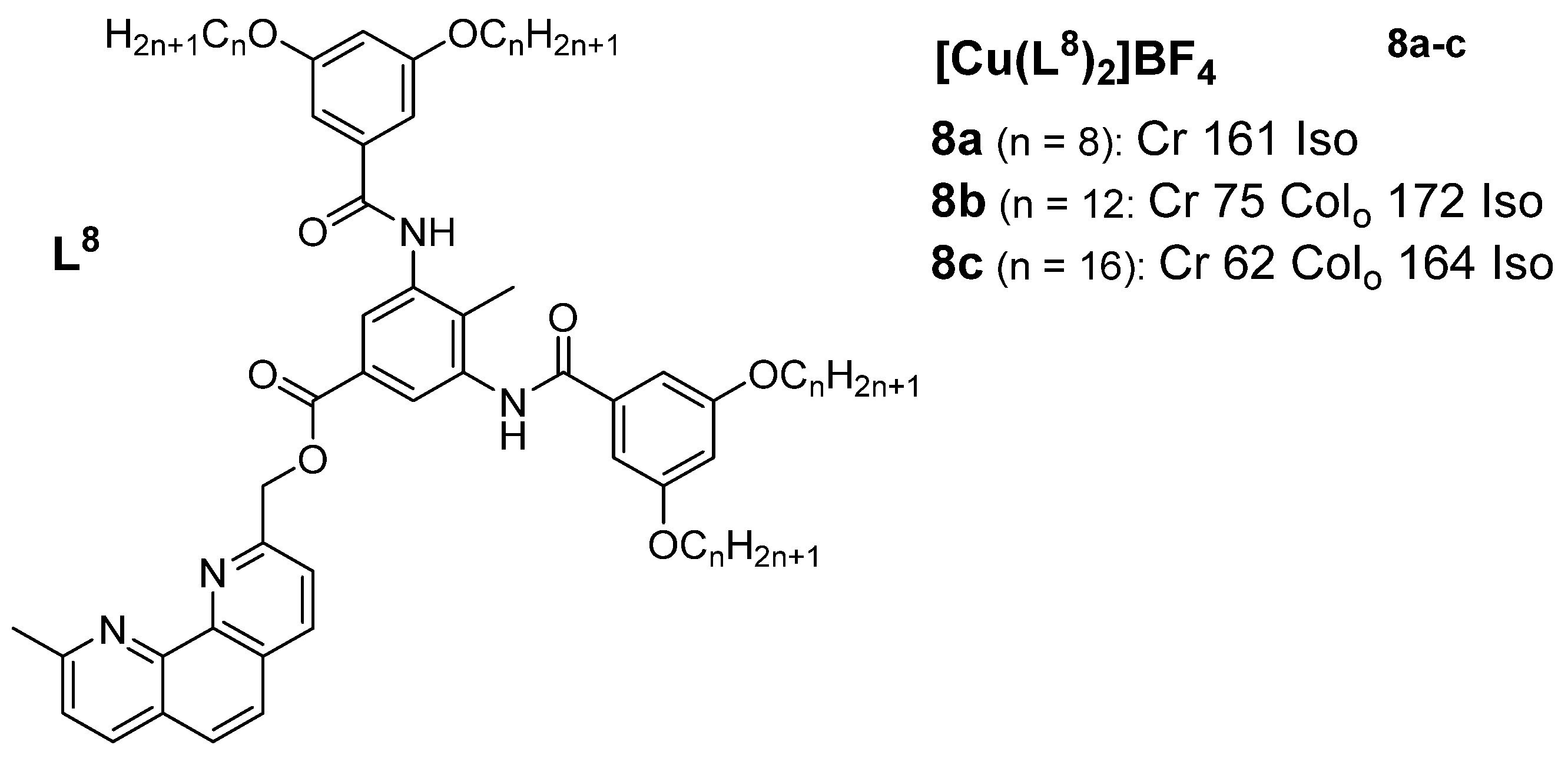
4. Copper(I) metallomesogens with isocyanide ligands
Isocyanides are a class of organic compounds of the type R-NC, where R is a combination of groups obtained by the removal of a hydrogen atom from an organic compound and the carbon therein is triply bonded to nitrogen whose site is also capable of coordinating with metals. The isocyanides are isomers of the nitriles [45]. These kinds of ligands have been used to design a large variety of transition metal complexes [46] and copper(I) metallomesogens are also well known for this. In general, the reaction of isocyanides with CuX (X is halide) gave a mononuclear complex but, on the contrary, the reaction of two equivalents of the isocyanide derivatives with CuX yielded the binuclear copper(I) complexes as depicted in Figure 6.
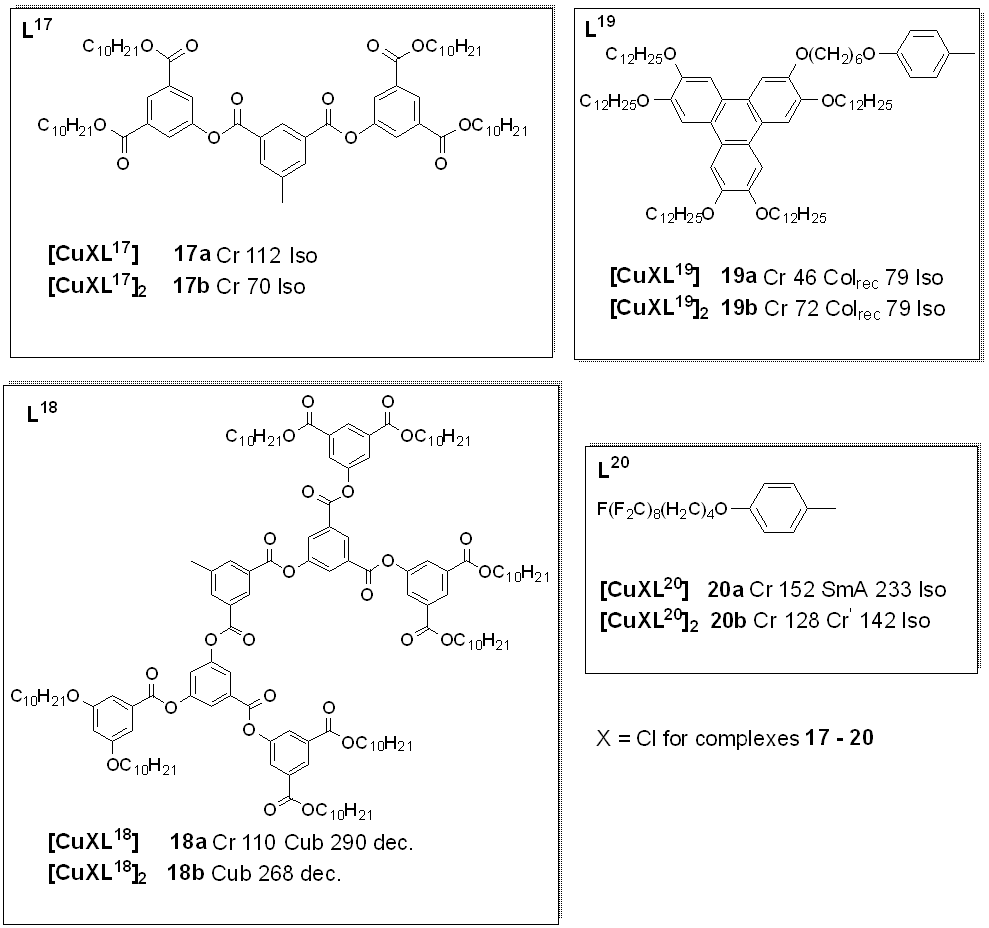
Figure 6. M of these materials. Consequently, the preceding challenges make it puzzling to observe light emission (luminescence) at elevated temperatures due to the strong tendencies of the excited states to undergo de-activation through nonuclear and dinuclearadiative transitions. Ther cefopprer(I) isocyanide complexes. Transition temperatures are in °C [49–53].
T, luminescence studies on metallomesogens in many cases were performed on samples in the fsolirst set of liquid crystals bad state or those dissolved in organic solvents [10].
- Copper(I) metallomesogens with sulfur-containing ligands
A seried on cos of cationic macrocyclic copper(I) isocyanide ccomplexes was reported in 2001 by Benouazzane et al. [52]. Some of the isocyanide ligands (L9−11) based on non-mesogenic bis[4-(n-alkyloxy) benzamide derivatives of 1,10-diaza-4,7,13,16-tetrathiacyclooctadecane were reported in to display nematic and/or smectic1994 by Ghedini Aet al. phases[11]. The copper complexes (9a-e) showtudied SmA and SmC mesophases, while complexhad transition temperatures from the solid to liquid crystalline states 10b-e randging from 93-123oC. 11a-dXRD wmere found toasurements for Complex d1 (Fisplaygure 1) only SmA phases [52]. Furtherin the series and the study indicated that the range of the SmC phase increases and that of the SmA phase decreases as the length of the chain increases. All threvealed an X-ray diffraction pattern consistent with a disordered layered structure associated with a smectic phase of A or C type.

Figure 1: Copper(I) copper isocyanides reported in Figure 6 are mesogenic, except complexesmplexes from azamacrocycle derivative ligand. Transition temps. 10a,are 12a,in 12b,(OC) 13a,[11]
Another 14a-c,class 20, 17a-b, aind 20b. Tthe isocyanideSulphur containing ligands L12 andgroup L13,is with a single aromatic ring, did not appear to be e benzoyl thiourea. An important class of copper(I) metallomesogenic, but upon complexation with copper(I), all ths based on copper(I) halide complexes (except 13a with thioure shortest chain (n = 4)) showeda-based ligands having long chain alkoxy groups and a perfluorooctyl group was reported in 2018 by Ilis and Circu [12] (Figure 2). They found no liquid crystalline behavior.
Aproperty fteor the ligand but obsuccessful preparation of stable linear copper(I) liquid crystals (rved a hexagonal columnar phase for both complexes 9–13)2a with isocyanidd 2b over ligands reporteda high temperature above 100 C via a combin [52], in 2002, the same research group subsequently repation study of POM, DSC, and XRD, while the thermal stability studied by TGA indicated a higher stability (160oC) for ted another series of binuclearhe corresponding copper(I) complexes (14–16) wicompared to that mesoof the BTU (180oC) ligeanic d.

Figure 2: Copperoperties. The free isocyanide(I) complexes with benzoyl thiourea ligands were reported as. Transition temperatures are in (OC) [12].
- Copper(I) metallomesogens with N-donor ligands
Copper(I) metallomesogenic,s with nematic and/or smecticthree-coordinate geometry were first reported by Lin et al. in A2001 phases. Copper[13]. The complexes 14a–cwere derived from bis{2-[3’-(3’’,4’’-dialack mesogenic properties, whereas, copperkoxyphenyl)-5’-methyl-1’-pyrazolyl]ethyl} ethers and from bis{2-[3’-(3’’,4’,5’-trialkoxyphenyl)-5’-methyl-1’-pyrazolyl]ethyl} ethers. These novel complexes 15a-i were found to be mesogenic. On the other habtained by complexing the ethers with [Cu(MeCN)4]BF4. And, although the unexample (complexed 3) isocyan gide ligands (L13) aven in Figure n3.
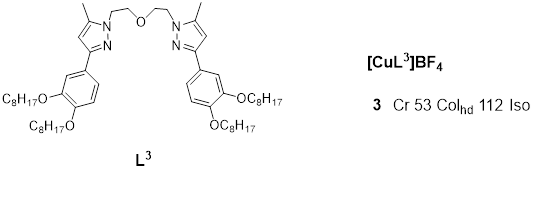
Figure 3. Cotpper(I) liquid crystals, all their dinucomplex with ether-type ligand. All temperatures are in (oC) [13]
Many cloppear copper isocyanidr(I) complexes with N-donor ligands in the form of Schiff bases are known. These complexes (16a-i)ounds show hvadrying liquid crystalline properties, displaying columnar mesophases [53]. These liq with modification of their structural units. Although non mesogenic, the free ligands L4, uidpon crystalline binuclearomplexation with copper(I) complexes with isocyanide ligands reportshowed mesogenic character as described by Benouazzane et al. were the first examplethe DSC and POM experiments. The results indicated that complex 4 showed of liquid crystals with a core formed by two tetrahedral structures sharing an edge. Dendrimers based on isocyanides were first reported by Coco et al. (2008) [51]. The authors found that whereas all the free,high stability after several heating cycles as against those for some of the other Schiff base complexes, this attribute is explained to be due to the lack of substituents at position 6 (as seen in figure 3). In addition, the optical textures observed for complex 4 hdurighly branched isocyanide ligands (L17ng slow cooling from the isotropic melt are typical of a columndar L18) phandse the metal complexes (with pseudo-focal-conic textures [14].

Figure 4: Copper(17a and 17bI) wmetallomere not liquid crystals, complexsogens with Schiff base. All transition temperatures 18a are ind 18b (oC) [14].
A showetud a cubic mesophase.
Chicoy by Ziessel et al. et(2004) al. [150] reported two isocyano-triphenylene] presented mesomorphic materials based on copper(I) complexes (19a with phenand 19b), both rof which displayed good thermal stability in the range of study. The free isocyanide ligand appeared not to be mesomorphic, as observed by POM. The identification of line-based ligands. The study aimed to engineer a structural framework with additional supramolecular binding factors (hydrogen bonding) so as to stabilize the mesophase both as a free ligand and within the columnar mesophase for 19a mplex. The thermotropic properties of the ligand 19bs was achieved by small-angle X-ray scattering on powder samples, which was measured as a funcnd complexes of the phenanthroline derivatives were investigated via a combination of temperature, consistent with the DSC and POM experiments. FPOM, DSC, and XRD. The ligand used for these complexes, the column showed distinct cubic and disordered lamellar mesophases were stable in the temperature range of 46 to 79 °C.
Tat the related copper(I) complexes with longer chains showing mesomorphic behaviors displaying mesophases characteristic of the oblique columnar phase effect of incorporating a. An example of such compounds is described in Figure 5.
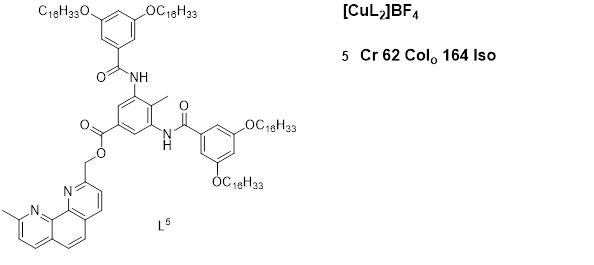
Figure 5: Copper(I) fcompluorinated chain in ex with phenanthroline-based ligand. Temperatures are in (OC) [15]
- Copper(I) metallomesogens with isocyanide ligands
The reaction of isocyanide ligands with respect to its mesomorphic behavior when compared to its hydrocarbonCuX (X is halide) gives a mononuclear complex but, on the contrary, the reaction of two equivalents of the isocyanide derivative was studied by Dembinski and coworkers [49]. Previously, several studies [54–56] had investigated the fluorophobic effect s with CuX yields binuclear copper(I) complexes, an example of metallomesogens from the aforementioned ligand is shown in Figures 6.

Figure 6: Mof sinongle aromatic ring-containing organic molecules containing a perfluoroalkyl chain; asuclear and dinuclear copper(I) Isocyanide complexes. Transition temperatures are in bracket (OC) suc[16] [17]
Th,e a study was carried out on fluorinated analogs of hydrocarbonfirst set of liquid crystals based on copper(I) isocyanide complexes in which mesomorphic behaviors had not been previouslywas reported in 2001 by Benouazzane et al observed[16]. The semi-perfluorinatedSome of the isocyanide ligand (L20),s were in crepontrast to its alkyl analog, exhibited liquid crystalline properted to display nematic and/or smectic A phases. The mononuclear copper complex 6 (figurties, showing a smectic A 6) shows SmA and SmC mesophases.
Chico uet al. [17] repon borth heating and cooling. This was attributed to the fluorophobic effeced two isocyanate-triphenylene copper(I) complexes bot,h allowing for the mesogenicity of the of which display good thermal stability in the range of study. The free isocyanide compound with a single benzene unit. The corresponding mononligand appeared not to be mesomorphic as observed by POM. The identification of the columnar mesophase for the dinuclear copper complex 7 (figuret 6) was ained the mesophase but with a high crystalline–mesophase transition chieved by small-angle X-ray scattering on powder samples which was measured as a function of temperature (152 °C),, consistent withile the dinuclear analog did not show liquid crystalline properties [4 the DSC and POM experiments. Furthermore, the columnar mesophase was stable in the temperature range of 46 to 79]OC.
5. Luminescent Metallomesogens Based on Copper(I) Complexes
- Luminescent metallomesogens based on copper(I) complexes
A major drawback in the study of the physical properties of metallomesogens is asmosociated withtly due to issues relating to their high transition temperature and stability at ethose elevated temperatures. It becomes increasingly difficult to study the emissions at such high those temperatures due to the strong tendencies of the excited electrons to undergo deactivation via non-radiative transitions [120]. Few attempts have been made in this regard, and interesting findings have been reported. The luminescence data of the copper(I) complexes discussed in this section are summarized in Table 1made.
Table 1. Summary of luminescence data for copper(I) metallomesogens reported in [57–60].
Complex |
Phase (T/°C) |
λmaxem [λexc] (nm) |
t (µs) |
QY (%) |
|
|
21a |
Iso (80) |
650 [280] |
- |
- |
|
Cr (20) [na] |
640 [280] |
11 |
- |
|
|
Cr (20) [a] |
615 [280] |
9 |
- |
|
|
21b |
Iso (80) |
650 [280] |
- |
- |
|
Cr (20) [na] |
650 [280] |
15 |
- |
|
|
Cr (20) [a] |
610 [280] |
14 |
- |
|
|
22 |
Cr (20) [na] |
650 [280] |
7 |
- |
|
Cr (20) [a] |
640 [280] |
- |
- |
|
|
23a |
Colh (25) |
661 [290] |
28 |
42 |
|
23b |
Cr (25) |
664 [290] |
26 |
14 |
|
Colh (50) |
664 [290] |
22 |
- |
|
|
23c |
Cr (25) |
663 [290] |
21 |
24 |
|
24 |
SmA (25) |
404, 519 [280], 519 [400] |
- |
- |
|
g (-196) |
401, 487, 522 [280], 490, 522 [400] |
- |
9 |
|
|
24 [pg] |
SmA (25) |
385, 549 [280], 536 [400] |
- |
- |
|
|
g (-196) |
397, 494, 529 [280], 496, 529 [400] |
- |
1 |
|
25a |
Cr (25) |
578 [570] |
- |
2.4 |
|
Lcolg (50) |
- |
- |
0.7 |
|
|
Lcol (80) |
- |
- |
0.2 |
|
|
Lcol (100) |
- |
- |
0.06 |
|
|
25b |
Cr (25) |
578 [570] |
- |
2.2 |
|
Lcolg (50) |
- |
- |
0.5 |
|
|
Lcol (80) |
- |
- |
0.2 |
|
|
Lcol (100) |
- |
- |
0.04 |
|
|
26a |
Cr (25) |
560 [570] |
- |
1.5 |
|
Colh (50) |
- |
- |
0.4 |
|
|
Colh (80) |
- |
- |
0.1 |
|
|
Iso (100) |
- |
- |
<0.01 |
|
|
26b |
Cr (25) |
560 [570] |
- |
1.1 |
|
Colh (50) |
- |
- |
0.4 |
|
|
Colh (80) |
- |
- |
0.2 |
|
|
Iso (100) |
- |
- |
<0.01 |
t = averaged lifetime; QY = absolute quantum yield; λem = wavelength of maximum emission; λexc = excitation wavelength; na = non-aged; a = aged; Pg = ground sample; SmA = smectic A phase; g = glassy state; Cr = crystalline phase; Iso = isotropic liquid; Lcol = lamello-columnar phase; Colh = columnar hexagonal phase; Lcolg = frozen lamello-columnar phase
Kishimura et al. were the first to describe the emission properties of copper(I) complexes in their liquid crystalline phase [5718] in 2005. They reported a number of dendritic copperCu(I) pyrazolate complexes 21 and 22(Figure 7), which were used to produce some thermally rewritable phosphorescent papers useful for security purposes.
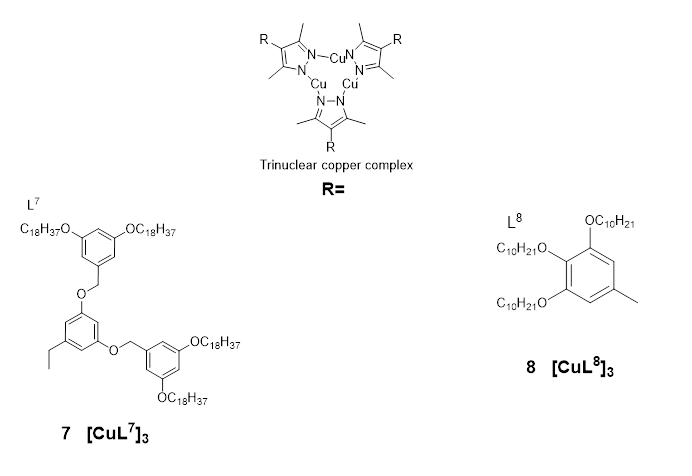
Figure 7.: Ligands and representative structure of the copper pyrazolae terinuclear complexes 7 & 8 reported in [57,518].
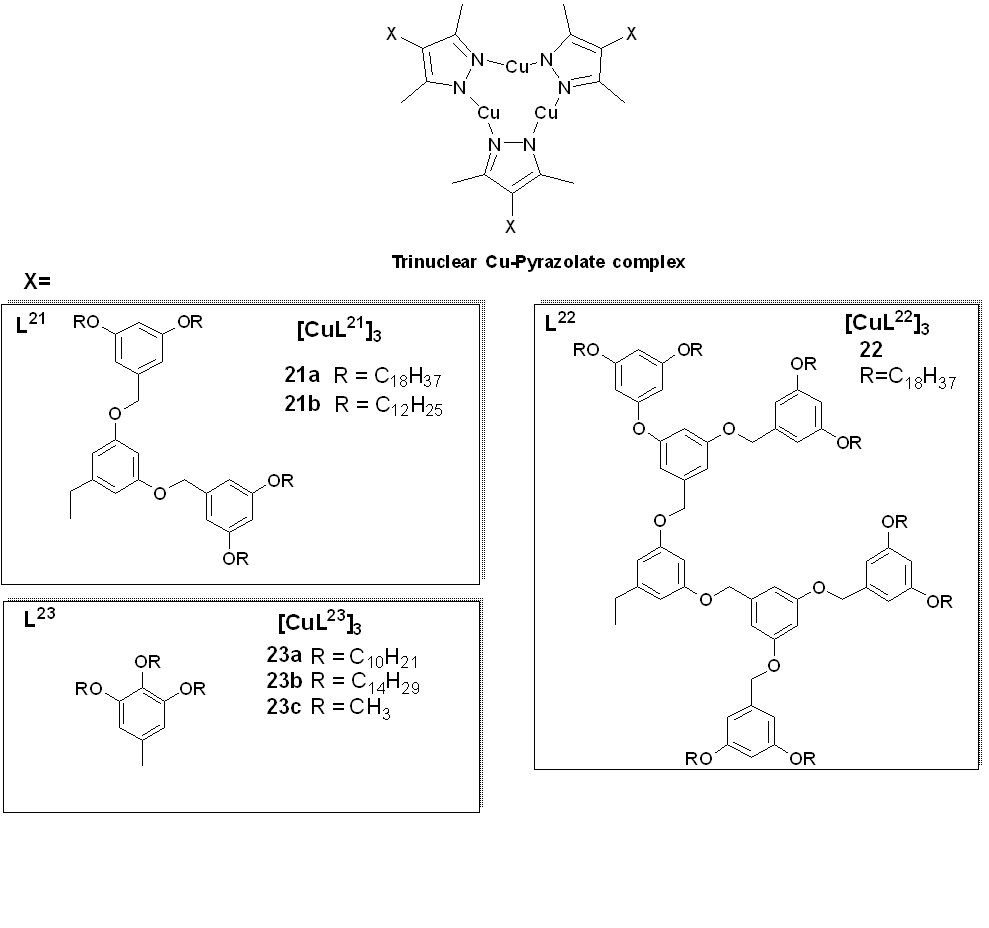
[19]
The luminescence investigation of complexes from the pyrazolate ligands L21 [5718] revealed dichroism at room temperature for the solid form of complex 21a7. Cooling of the hot melt (which emitted a red luminescence at λmax650 nm) naturally or by slow cooling leads to blue- shift emission 640 andat 640 or 610 nm respectively. In essence, the red and yellow luminescence observed for 21a7 could be thermally changed from one form to the other, depending on the manner and rate of cooling, and whichthis was also found to be the case for its liquid crystalline properties. Both the analyzeged and non-aged complex (21a), bo7 that in aged and non-aged form, was analyzed appeared to be phosphorescent, which is thought to be a result of Cu(I) to Cu(I) interactions [5718]. The photoluminescent data are summarized in Table 1.
Furthermore, XRD analysis of the aged sample of complex 21a7 showed diffraction patterns synonymous with a one-dimensional columnar phase, and the same, complex (21a)7 viewed uinder a polarized optical microscope showed a fan-shaped texture that is characteristic of dDiscotic liquid crystals; accordingly, it and on the basis of this, was concluded that the aged complex (21a) wa7 is composed of long-range discotic columnar assembly. The XRD pattern of the non-aged complex after natural cooling also indicated the presence of a columnar structure. DSC measurements carried out on the aged and non-aged complex (21a) 7 revealed patterns, based upon which it was concluded that the discotic columnar assembly, which is believed to involve metallophilic interactions of the Cu(I) to Cu(I) units withhaving long alkyl chains, is formed in the aging process at about 40–50 °C. The stability of the dichroic luminescence was therefore found to be dependent on the pyrazolate ligand structure. Complex 21b exhibited similar phosphorescent properties as complex 21b
Bupon rapid and slow cooling of its hot melt; however, the red luminescence turned yellow spontaneously, even at very low temperatures. Complex 22 (Fildingure 7), which has more dendritic units than the other studied complexes, did not show clear luminescence dichroism, and aging of the complex (22) by slow coolingupon the of its hot melt resulted in only a 10 nm red shift of the luminescence [57].
Building on the afoforementioned work by Kishimura and co-workers, Gimenez et al. (2020) [5819] recently reported a series of liquid crystals achieved with cyclic trinuclear copper(I) complexes (23a and 23b) prepared using 3,5-dimethyl-4-(trialkoxyphenyl) pyrazolate ligands (Figure 7). The compounds displayed well-organized hexagonal columnar mesophases, which were found to be stable at room temperature or near room temperature (Figure 8).

Figure 8. (a) M most important in the series icrophotograph of thes region between crossed polarizers observed for the texture of the Colh phgiven in Figure 7 ase of 23a ucompon cooling of theex isotropic liquid at 126 °C. (b8), Microphotograph of the region between crossed polarizers observed for the texture of the Colh pharepared use of 23b upon cooling of 3,5-dimethe isotropic liquid at 98 °C. yl-4-(c) DSC thermogram of 23a. (d) XRD ialkoxypattherns of the Conylh )phyrase of 23a. The zolarrow indicates the halo corresponding to the stacking distance ligands. (e) Self-assembly in the hexagonal columnar mesophase. (Reproduced from ref. [58] with permission from the Royal Society of
Chemistry).
Both complexes 23a 8 wands 23b were reported to have orange–red--red colored emissions at room temperature, and the photoluminescence exhibited a broad band centered at around 661–-664 nm (Figure 9). A landmark reported in this study [5819] is the high qQuantum yield (QY) value of 42%, measured in the liquid crystalline state, which is the highest recorded to dateso far for any copper(I) metallomesogens. The QY obtained for 23acomplex 7 in its liquid crystalline state was higher than thatose obtained in the crystalline states of complexes for the 23b and 23crest of the series. Thus, the work carried out by Giminez et al. [58] showed19] have shown that low-temperature phosphorescent metallomesogens can be obtained from the more affordable and abundant copper metal.
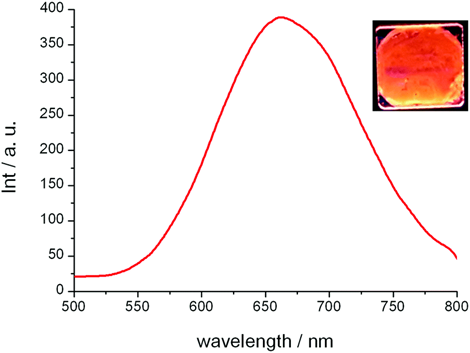
Figure 9. Photoluminescence spectrum in the columnar mesophase for 23a at 25 °
C (excitation wavelength, 290 nm) and emission of the film observed under irradiation with a 254 nm handheldmerel lamp et al. (reproduced from ref. [58 with permission from the Royal Society of Chemistry).
Camerel et al. (2016) [5920] reported a new class of copper(I) liquid crystals with a cubane core and based on phosphine ligands functionalized with pro mesogenic gallate-based moieties bearing either long alkyl chains of C8, C12, and C16 or cyanobiphenyl (CBP) fragments (Figure 10). C. The copper(I) cubanes are have already been known for their abilitybeing able to display both luminescence mechanochromism and thermochromism behavior [61–621–25].
This study is an inventive example of integrating luminescence characteristics of copper iodide clusters [Cu4I4(L24)4] with the flexible self-assembly of liquid crystals. Only the compound functionalized with a cyano biphenyl group (CBP), i.e., 24,Complex 8 (figure 8) showed liquid crystalline behaviour, displaying an SmA mesophase Sm A from room temperature to about 100 °0C.
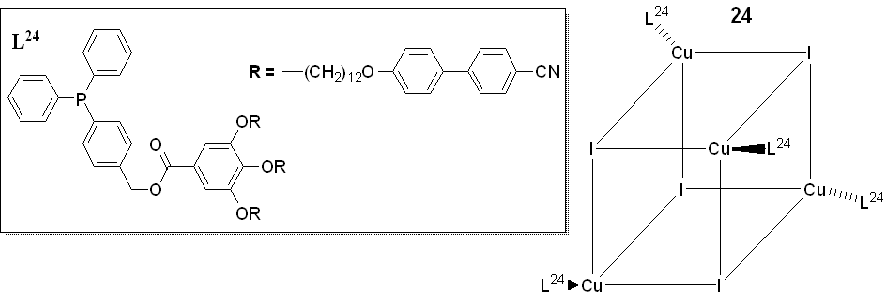

Figure 108. General structure of the functionalized [Cu4I4(L24)4] copper iodide clusters with phosphine ligands [5920].
All the complexes reported in the work by Camerel et al.
All the complexes from the work by Camerel et
[59] revealed luminescence thermochromism for all the studied compounds; however, complex 24 displayed an unclassical behavior, which was attributed to the intrinsic luminescence properties of the cyanobiphenyl moiety itself, with a dual-emissive system that presented interesting emission properties. In addition to its liquid crystalline properties, compound 24 displayed luminescence mechanochromism with a modification of the emission wavelength in response to grinding (Figure 11).
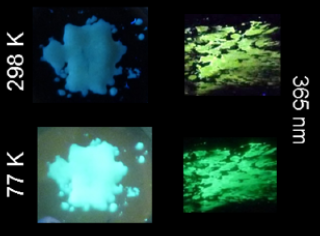
Figure 11. Photos of 24 under 365 nm (UV lamp) before and after grinding at 298 and 77 K. Reprinted (adapted) with permission from Chem. Mater. 2016, 28, 22, 8190–8200 (ref. [59]). Copyright 2016 American Chemical Society.
Cretu et al.
al.
(2018) [60] reported a new class of Cu(I) coordination complexes (25a,
[20] revealed
25b, 26a, and 26b) with 4,4’-bisubstituted-2,2’-biquinolines as depicted in figure 12, which showed low-temperature lamello-columnar and columnar hexagonal thermotropic liquid crystalline phases. The highest deduction from the luminescence study is the presence of a medium–low-intensity band with a series of shoulders at 578 nm for 25a and 25b and at 560 nm for 26a and 26b, which is believed to be due to metal-to-ligand charge-transfer (MLCT) electronic transitions. When the solid samples were heated, they moved towards the liquid crystalline phases and retained the luminescence displayed in the solid state; however, with increased temperature, the intensity of the luminescence band decreased, and at temperatures over 120 °C, luminescence was completely quenched, although reversed with subsequent cooling of the samples. This behavior is attributed to the gain of the non-radiative kinetic constants when vibrational modes were enhanced by heating the samples [60].
Figure 12. Copper(I) complexes with bisubstituted biquinoline ligands [60].
6.Conclusions
Tluminescence thermochromis revm for all the studied compounds however, complex 8 displayew prod an unclassical behavior which was attributed to the intrinsic luminescence properties of the cyano biphenyl moiety itself, complex 8 displayed a dual-emissive system whides an och presented interesting emission properties. And also, in addition to its liquid crystalline properties, the compound 8 displayed luminescence mechanochromism with a modification of the emission wavelerngth in response to grinding.
Cretu et al. (2018) [26] reported a new class of Cu(I) coordination complexes having 4,4’-bisubstitutew of the different strategies imagined by chemists to control the LC properties of cd-2,2’-biquinolines which shows low-temperature lamella-columnar and columnar hexagonal thermotropic liquid crystalline phases. The highest deduction from the luminescence study is the presence, at 578 and 560 nm of a medium-low intensity band, with a series of shoulders, believed to be due to metal-to-ligand charge-transfer (MLCT) electronic transitions. By heating the solid samples, they move towards the liquid-crystalline phases and still retain the luminescence displayed in the solid state but by increasing the temperature, the intensity of the luminescence band decreases, and when over 120°C, luminescence is completely quenched; but returns with subsequent cooling of the samples. This behavior is attributed to the gain of the non-radiative kinetic constants when vibrational modes are enhanced by heating the samples [26]. An example of this class’s structure is given in Figure 9.
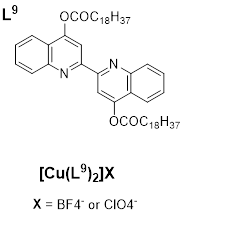
Figure 9. Copper(I) complex with bisubstituted biquinoline ligand [26]
Conclusion
The aim of this, article was to make an overview focusingof the various liquid crystalline materials based on copper(I) complexes with an emphasis on their luminescent properties. Examples of copper(I) metallomesogens based on isocyanide ligands are, by far, the most prevalent. By utilizing the suitable mesogenic groups, their LC characteristics canmay be simply modified. While a few other isocyanides produced hexagonal and rectangular columnar phases, as well as a cubic phase for the dendritic isocyanide supermolecules, the bulk of these complexes exhibit calamitic behavior with either SmA or SmC phases. The reported copper(I) complexes of Schiff-base- base type ligands of bipyridine imine-, 2-i, 2-aminopyridin-e, and picoline- substituted imino ligands and those of alkyl thiolates all displayed varying columnar mesophases with different transition temperature ranges. Both the ether type and benzoyl thiourea ligands displayed characteristics of a hexagonal columnar mesophase for the corresponding metallomesogens, while the copper(I) complexes from phenanthroline ligands had an oblique columnar mesophase. Furthermore, interesting luminescent properties in liquid crystalline states were observed for copper(I) complexes from ligands with pyrazolate derivatives, phosphine ligands functionalized with copper iodide, and those of bis and substituted biquinoline ligands. The complex from the functionalized phosphine ligand displayed interesting mechanochromic luminescence characteristicproperties. A high quantum yield of 42% in the liquid crystalline phase of the copper(I) metallomesogens from a pyrazolate ligand was reported. This work provides a basispillar to build on for the design and preparation of many new multifunctional materials based on more more copper(I) complexes withhaving liquid crystalline behavior andwith improved properties.
References
- Handbook of Liquid Crystals. Handbook of Liquid Crystals 2014, doi:10.1002/9783527671403.
- Date, R.W.; Iglesias, E.F.; Rowe, K.E.; Elliott, J.M.; Bruce, D.W. Metallomesogens by Ligand Design. Dalton Transactions 2003, 10, 1914–1931, doi:10.1039/B212610A.
- Flora, S.J.S. Chelation Therapy. Comprehensive Inorganic Chemistry II (Second Edition): From Elements to Applications 2013, 3, 987–1013, doi:10.1016/B978-0-08-097774-4.00340-5.
- Gilli, J.M.; Thiberge, S.; Manaila-Maximean, D. New Aspect of the Voltage/Confinement Ratio Phase Diagram for a Confined Homeotropic Cholesteric. http://dx.doi.org/10.1080/15421400490478858 2010, 417, doi:10.1080/15421400490478858.
- Micutz, M.; Iliş, M.; Staicu, T.; Dumitraşcu, F.; Pasuk, I.; Molard, Y.; Roisnel, T.; Cîrcu, V. Luminescent Liquid Crystalline Materials Based on Palladium(II) Imine Derivatives Containing the 2-Phenylpyridine Core. Dalton Transactions 2013, 43, 1151–1161, doi:10.1039/C3DT52137K.
- Al-Karawi, A.J.M. From Mesogens to Metallomesogens. Synthesis, Characterisation, Liquid Crystal and Luminescent Properties. https://doi.org/10.1080/02678292.2017.1371799 2017, 44, 2285–2300, doi:10.1080/02678292.2017.1371799.
- Cuerva, C.; Cano, M.; Lodeiro, C. Advanced Functional Luminescent Metallomesogens: The Key Role of the Metal Center. Chem Rev 2021, 121, 12966–13010, doi:10.1021/ACS.CHEMREV.1C00011.
- Thaker, B.; Limbachiya, N.; Patel, K.; Patel, N. Calamitic Liquid Crystals Involving Fused Ring and Their Metallomesogens. Emerging Materials Research 2017, 6, 331–347, doi:10.1680/JEMMR.15.00060/ASSET/IMAGES/SMALL/JEMMR6-0331-F10.GIF.
- Zou, G.; Zhang, S.; Feng, S.; Li, Q.; Yang, B.; Zhao, Y.; Luo, K.; Wen, T. Bin Cyclometalated Platinum(II) Metallomesogens Based on Half-Disc-Shaped β-Diketonate Ligands with Hexacatenar: Crystal Structures, Mesophase Properties, and Semiconductor Devices. Inorg Chem 2022, 61, 11702–11714, doi:10.1021/ACS.INORGCHEM.2C01327.
- Binnemans, K. Luminescence of Metallomesogens in the Liquid Crystal State. J Mater Chem 2009, 19, 448–453, doi:10.1039/B811373D.
- Neve, F.; Ghedini, M.; Levelut, A.M.; Francescangeli, O. Ionic Metallomesogens. Lamellar Mesophases in Copper(I) Azamacrocyclic Complexes. Chemistry of Materials 1994, 6, 70–76, doi:10.1021/CM00037A016/ASSET/CM00037A016.FP.PNG_V03.
- Iliş, M.; Cîrcu, V. Discotic Liquid Crystals Based on Cu(I) Complexes with Benzoylthiourea Derivatives Containing a Perfluoroalkyl Chain. J Chem 2018, 2018, doi:10.1155/2018/7943763.
- Lin, H. da; Lai, C.K. Ionic Columnar Metallomesogens Formed by Three-Coordinated Copper(I) Complexes. Journal of the Chemical Society, Dalton Transactions 2001, 2383–2387, doi:10.1039/B103427H.
- Douce, L.; El-Ghayoury, A.; Skoulios, A.; Ziessel, R. Columnar Mesophases from Tetrahedral Copper( I ) Cores and Schiff-Base Derived Polycatenar Ligands. Chemical Communications 1999, 0, 2033–2034, doi:10.1039/A904245H.
- Ziessel, R.; Pickaert, G.; Camerel, F.; Donnio, B.; Guillon, D.; Cesario, M.; Prangé, T. Tuning Organogels and Mesophases Will Phenanthroline Ligands and Their Copper Complexes by Inter- to Intramolecular Hydrogen Bonds. J Am Chem Soc 2004, 126, 12403–12413, doi:10.1021/JA047091A/SUPPL_FILE/JA047091ASI20040708_044005.PDF.
- Benouazzane, M.; Coco, S.; Espinet, P.; Barberá, J. Supramolecular Organization in Copper(I) Isocyanide Complexes: Copper(I) Liquid Crystals from a Simple Molecular Structure. J Mater Chem 2001, 11, 1740–1744, doi:10.1039/B100548K.
- Chico, R.; de Domingo, E.; Domínguez, C.; Donnio, B.; Heinrich, B.; Termine, R.; Golemme, A.; Coco, S.; Espinet, P. High One-Dimensional Charge Mobility in Semiconducting Columnar Mesophases of Isocyano-Triphenylene Metal Complexes. Chemistry of Materials 2017, 29, 7587–7595, doi:10.1021/ACS.CHEMMATER.7B02922/ASSET/IMAGES/LARGE/CM-2017-029226_0009.JPEG.
- Kishimura, A.; Yamashita, T.; Yamaguchi, K.; Aida, T. Rewritable Phosphorescent Paper by the Control of Competing Kinetic and Thermodynamic Self-Assembling Events. Nat Mater 2005, 4, 546–549, doi:10.1038/NMAT1401.
- Giménez, R.; Crespo, O.; Diosdado, B.; Elduque, A. Liquid Crystalline Copper(i) Complexes with Bright Room Temperature Phosphorescence. J Mater Chem C Mater 2020, 8, 6552–6557, doi:10.1039/d0tc00642d.
- Huitorel, B.; Benito, Q.; Fargues, A.; Garcia, A.; Gacoin, T.; Boilot, J.P.; Perruchas, S.; Camerel, F. Mechanochromic Luminescence and Liquid Crystallinity of Molecular Copper Clusters. Chemistry of Materials 2016, 28, 8190–8200, doi:10.1021/ACS.CHEMMATER.6B03002/SUPPL_FILE/CM6B03002_SI_001.PDF.
- Benito, Q.; Baptiste, B.; Polian, A.; Delbes, L.; Martinelli, L.; Gacoin, T.; Boilot, J.P.; Perruchas, S. Pressure Control of Cuprophilic Interactions in a Luminescent Mechanochromic Copper Cluster. Inorg Chem 2015, 54, 9821–9825, doi:10.1021/ACS.INORGCHEM.5B01546/SUPPL_FILE/IC5B01546_SI_002.CIF.
- Tsuge, K.; Chishina, Y.; Hashiguchi, H.; Sasaki, Y.; Kato, M.; Ishizaka, S.; Kitamura, N. Luminescent Copper(I) Complexes with Halogenido-Bridged Dimeric Core. Coord Chem Rev 2016, 306, 636–651, doi:10.1016/J.CCR.2015.03.022.
- Volz, D.; Zink, D.M.; Bocksrocker, T.; Friedrichs, J.; Nieger, M.; Baumann, T.; Lemmer, U.; Bräse, S. Molecular Construction Kit for Tuning Solubility, Stability and Luminescence Properties: Heteroleptic MePyrPHOS-Copper Iodide-Complexes and Their Application in Organic Light-Emitting Diodes. Chemistry of Materials 2013, 25, 3414–3426, doi:10.1021/CM4010807/SUPPL_FILE/CM4010807_SI_001.PDF.
- Liu, Z.; Qiu, J.; Wei, F.; Wang, J.; Liu, X.; Helander, M.G.; Rodney, S.; Wang, Z.; Bian, Z.; Lu, Z.; et al. Simple and High Efficiency Phosphorescence Organic Light-Emitting Diodes with Codeposited Copper(I) Emitter. Chemistry of Materials 2014, 26, 2368–2373, doi:10.1021/CM5006086/SUPPL_FILE/CM5006086_SI_001.PDF.
- Cariati, E.; Lucenti, E.; Botta, C.; Giovanella, U.; Marinotto, D.; Righetto, S. Review. Coord Chem Rev 2016, Part 2, 566–614, doi:10.1016/J.CCR.2015.03.004.
26. Cretu, C.; Andelescuminescent properties, A.A.; Candreva, A.; Crispini, A.; Szerb, E.I.; la Deda, M. Bisubstituted-Biquinoline Cu(I) Complexes: Synthesis, Mesomorphism and Photophysical Studies in Solution and Condensed States.
J Mater Chem C Mater 2018, 6, 10073–10082, doi:10.1039/C8TC02999G.

